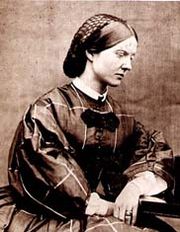- Mary Ward (scientist)
-
For other people named Mary Ward, see Mary Ward (disambiguation).
Mary Ward (27 April 1827 – 31 August 1869) was an Irish amateur scientist who was killed when she fell under the wheels of an experimental steam car built by her cousins. As the event occurred in 1869, she is the world's first known motor vehicle accident victim. This incident occurred 17 years prior to the 1886 invention of the Benz Patent-Motorwagen, which is popularly regarded as the first automobile, neglecting the prior history of steam-powered motorcars.
Contents
Early life
During the 19th century, when most women had little encouragement for, or apparent interest in, a science education, Mary was unusual. She was born Mary King in Ballylin, near Ferbane, Co. Offaly on 27 April 1827, the youngest child of Henry and Harriett King. She and her sisters were educated at home, as were most girls at the time. However, her education was slightly different from the norm because she was of a renowned scientific family. She was interested in nature from an early age, and by the time she was three years old she was collecting insects.[citation needed]
Interests
Mary King became a keen stargazer, like her cousin William Parsons, 3rd Earl of Rosse. He was building the Leviathan of Parsonstown, a reflecting telescope with a six-foot mirror which remained the world’s largest until 1917. Mary often visited him at his home and, as she was a good artist, sketched each stage of the process. These sketches, along with photographs made by Parson’s wife Mary Rosse, were used recently to help restore the telescope.
Mary also drew insects, and the astronomer James South observed her doing so one day. She was using a magnifying glass to see the tiny details, and her drawing so impressed him that he immediately persuaded her father to buy her a microscope. For Mary, this was the beginning of a lifelong passion. She began to read everything she could find about microscopy, and taught herself until she had an expert knowledge. She made her own slides from slivers of ivory, as glass was difficult to obtain, and prepared her own specimens. The physicist David Brewster asked her to make his microscope specimens, and used her drawings in many of his books and articles.
Distinctions
Universities and most societies would not accept women, but Mary obtained information any way she could. She wrote frequently to scientists, asking them about papers they had published. During 1848, Parsons was made President of the Royal Society, and visits to his London home meant that she met many scientists.
She was one of only three women on the mailing list for the Royal Astronomical Society. (Of the others, one was Queen Victoria and the other was Mary Somerville, a scientist for whom Somerville College at Oxford University was named.)
Marriage
On 6 December 1854, Mary married Henry William Crosbie Ward (5th Viscount Bangor) of Castleward, County Down. They had three sons and five daughters.
Publications
When Mary Ward wrote her first book, 'Sketches with the microscope', she apparently believed that no one would print it because of her gender or lack of academic credentials. She published 250 copies of it privately, and several hundred handbills were distributed to advertise it. The printing sold during the next few weeks, and this was enough to make a London publisher take the risk and contract for future publication. The book was reprinted eight times between 1858 and 1880.
She wrote two other books, one of which was a beginner’s guide to astronomy, and several articles. She illustrated all her own work and many books and papers by other scientists.
Death
Mary Ward has the distinction of being the first fatality of a car accident. William Parsons’ sons, as keen on mechanics as their father, had built a steam-powered automobile. It was thought at the time that steam transport would be developed greatly during the near future (this was true for trains, but did not in fact become true for cars due to the development of petroleum engines). Steam cars were unreliable, and they did too much damage to the already uneven roads. In 1865 the Red Flag Act imposed a speed limit of four miles per hour for the countryside and two miles per hour in towns. This effectively ended the popularity of motorcars, but some enthusiasts still had one, often home made, like the Parsons’ vehicle. On 31 August 1869, Mary and her husband Henry Ward, 5th Viscount Bangor were travelling in it with the Parsons boys and their tutor, when Mary was thrown from the car on a bend in the road. She fell under its steel wheel and died almost instantly. When a doctor, who lived near the scene of the accident, arrived within moments, he found her cut, bruised and bleeding from the ears. The fatal injury was a broken neck.
Mary’s microscope, accessories, slides and books are on display in her husband’s home, Castle Ward, County Down. William Parsons’ home at Birr Castle, County Offaly, is also open to the public.
She is the great-grandmother of the English actress and author Lalla Ward, known best for her role as Romana in Doctor Who.
See also
- Bridget Driscoll
- Henry H. Bliss
References
- Irish Universities Promoting Science Group. Profile of Mary Ward. Retrieved on May 30, 2005.
- Offaly Historical and Archaeological Society, Mary Ward 1827 - 1869.
Categories:- 1827 births
- 1869 deaths
- Irish writers
- Irish scientists
- Irish astronomers
- Irish entomologists
- Women scientists
- Road accident deaths in the Republic of Ireland
- Irish women artists
- People from County Offaly
- 19th-century Irish people
Wikimedia Foundation. 2010.

